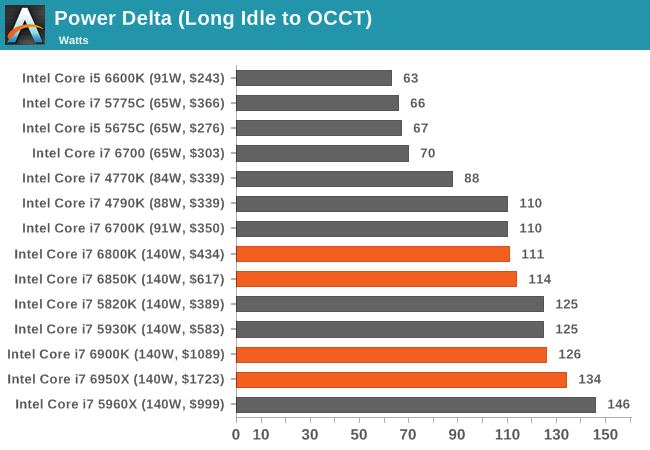The Intel Broadwell-E Review: Core i7-6950X, i7-6900K, i7-6850K and i7-6800K Tested
by Ian Cutress on May 31, 2016 2:01 AM EST- Posted in
- CPUs
- Intel
- Enterprise
- Prosumer
- X99
- 14nm
- Broadwell-E
- HEDT
Load Delta Power Consumption
Power consumption was tested on the system while in a single MSI GTX 770 Lightning configuration with a wall meter connected to the OCZ 1250W power supply. This power supply is Gold rated, and as I am in the UK on a 230-240 V supply, leads to ~75% efficiency > 50W, and 90%+ efficiency at 250W, suitable for both idle and multi-GPU loading. This method of power reading allows us to compare both the power management of the BIOS and the board's ability to supply components with power under load, and includes typical PSU losses due to efficiency.

Each of the Broadwell-E SKUs are rated at 140W, however they vary between 6 cores and 10 cores and with different frequencies. Normally one would assume that the core/frequency ratio would be adjusted to match TDP, but ultimately using more cores can consume more power. We see a distinct increase in power consumption moving up the product stack.
Prime95 Core Loading
For this review, we also looked into peak delta power draw when varying the number of cores using Prime95’s mode for peak power consumption. Prime95 identifies cores with multiple threads and adjusts its loading/pinning accordingly.

Broadwell-E Overclocking
Methodology
Our standard overclocking methodology is as follows. We select the automatic overclock options and test for stability with PovRay and OCCT to simulate high-end workloads. These stability tests aim to catch any immediate issues with memory or CPU errors.
For manual overclocks, based on the information gathered from previous testing, we start off at a nominal voltage and CPU multiplier, and the multiplier is increased until the stability tests are failed. The CPU voltage is increased gradually until the stability tests are passed, and the process repeated until the motherboard reduces the multiplier automatically (due to safety protocols) or the CPU temperature reaches a stupidly high level (100ºC+). Our test bed is not in a case, which should push overclocks higher with fresher (cooler) air.
Overclock Results
Due to time constraints we were only able to overclock the i7-6950X using the MSI X99A Gaming Carbon motherboard. MSI has improved its overclocking options as of late on the Z170 platform to make it easier to use, but our BIOS did not have those most recent updates, particularly for load line calibration. However, our sample hit 4.1 GHz at 1.30 volts before the OCCT load temperatures were prohibitive to move up any further. We saw similar things when testing the mainstream Broadwell parts with Iris Pro, which shows that this sort of overclocking performance might be indicative of the silicon itself.
That being said, speaking with our contacts at various motherboard manufacturers, we're told that 4.1 GHz is a reasonably average processor result for Broadwell-E. Some processors will hit 4.3 GHz on air at around the same voltage, whereas others need up to 1.4 volts, and thus results will depend on the cooling setup used or the thermal characteristics of the silicon. I have also been told that AVX is a different story: for any peak frequency attained normally, AVX overclock stable frequencies will be around 200-300 MHz lower.











205 Comments
View All Comments
RealLaugh - Tuesday, May 31, 2016 - link
Why are there no 4k resolution benchmarks, did I miss something?Surely the consumer base for this tech are not going to be playing on 1080p?!
Isn't that where the CPUs would start to get ahead of the i5 and i7 products?
Call me out if I'm mistaken!
dannybates - Tuesday, May 31, 2016 - link
You are mistaken.Lower Res = More CPU Dependent, Less GPU Dependent
Higher Res = More GPU Dependent, Less CPU Dependent
Lowering the resolution of a computer game or software program increases the dependency on the CPU. As the resolution decreases, less strain is placed on the graphics card because there are fewer pixels to render, but the strain is then transferred to the CPU. At a lower resolution, the frames per second are limited to the CPU's speed.
RealLaugh - Tuesday, May 31, 2016 - link
ok thanks now I know.adamod - Wednesday, June 1, 2016 - link
i shall purchase a xeon e5 2699 v4 and a GT210.....i was to play crysis at 800x600 but ULTRA!!!Ph0b0s - Tuesday, May 31, 2016 - link
The only thing for gaming might be scaling with more cores. With Directx 12, it makes better use of multi-core CPU's. It would be good for Anandtech to do a story on how Directx 12 scales with more cores, now we can have up to 10. I don't know if there are enough DirectX 12 games to do this yet? If you don't get an benefit for having more that 4 cores then Broadwell-E will not be needed for gaming. If you get a benefit over 4 cores that will be the case for needing Broadwell-E for gaming.jabber - Tuesday, May 31, 2016 - link
Yeah I'm looking forward to playing some DX12 games in 2018 with my DX14 capable GPU. C'mon folks that's how it always works.adamod - Wednesday, June 1, 2016 - link
here is some limited date....it shows ashes and gears at least along with some synthetics:http://www.pcworld.com/article/3039552/hardware/te...
Wardrop - Tuesday, May 31, 2016 - link
Good banner photo! Liking it.r3loaded - Tuesday, May 31, 2016 - link
Yay, price gouging!AMD pls save us.
ochadd - Tuesday, May 31, 2016 - link
Pricing is just prohibitively high imho. I'm still rocking SandyBridge and was hoping the lowest end would basically by a 5820 with 40 lanes unlocked. Would have made a great upgrade. With the pricing I think it's best to wait until the next version of the regular desktop (Kaby Lake?) to pull the trigger.